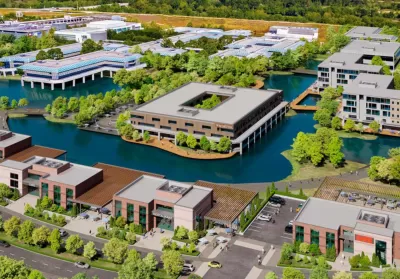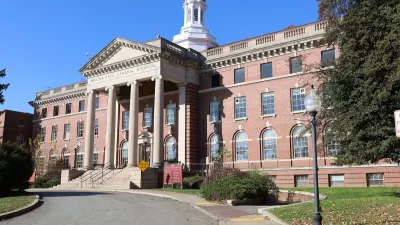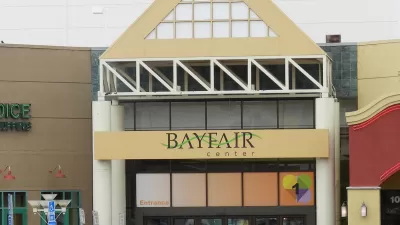The former ConocoPhillips campus, built as a self-sufficient complex complete with a lagoon and fitness center, will be repurposed into a mixed-use waterfront development.

A 63-acre former corporate campus in Houston will be redeveloped into a mixed-use project, reports Trevor Schillaci in the Architect’s Newspaper. “The effort will add new office space, residential, retail, and restaurants around the perimeter of the site.”
The original office park, built for Conoco (later ConocoPhillips) in 1984, “comprises 16 buildings arranged in five groups, with an additional service structure situated at the center of the complex.” Designed as a ‘technoburb,’ the complex aimed to provide everything workers needed: “While much of the complex is programmed as office (and garden) space, the central service building combines parking facilities, a gym, a computer center, staff cafeterias, a credit union, and a travel agency under one roof.”
“Recognizing that a post-pandemic workforce prefers low-rise, low-density workspaces, as opposed to the high-density office towers, the plan proposed by Midway reduces the original 1.3 million-square-foot site down to 650,000 square feet, while repurposing the remaining space to accommodate other uses,” Schillaci explains. Buildings will be remodeled into apartment units, a boutique hotel, as well as restaurants and bars with waterfront views. The developer plans to build on the complex’s sustainability elements by preserving on-site trees and green space and repurposing food and water waste. With demand for physical offices remaining low and the shift to remote work lasting longer than many predicted, adaptive reuse is gaining momentum as property owners look to new uses for now-obsolete office space.
FULL STORY: Midway announces redevelopment of Kevin Roche–designed ConocoPhillips office park in Houston

Study: Maui’s Plan to Convert Vacation Rentals to Long-Term Housing Could Cause Nearly $1 Billion Economic Loss
The plan would reduce visitor accommodation by 25,% resulting in 1,900 jobs lost.

North Texas Transit Leaders Tout Benefits of TOD for Growing Region
At a summit focused on transit-oriented development, policymakers discussed how North Texas’ expanded light rail system can serve as a tool for economic growth.

Why Should We Subsidize Public Transportation?
Many public transit agencies face financial stress due to rising costs, declining fare revenue, and declining subsidies. Transit advocates must provide a strong business case for increasing public transit funding.

How to Make US Trains Faster
Changes to boarding platforms and a switch to electric trains could improve U.S. passenger rail service without the added cost of high-speed rail.

Columbia’s Revitalized ‘Loop’ Is a Hub for Local Entrepreneurs
A focus on small businesses is helping a commercial corridor in Columbia, Missouri thrive.

Invasive Insect Threatens Minnesota’s Ash Forests
The Emerald Ash Borer is a rapidly spreading invasive pest threatening Minnesota’s ash trees, and homeowners are encouraged to plant diverse replacement species, avoid moving ash firewood, and monitor for signs of infestation.
Urban Design for Planners 1: Software Tools
This six-course series explores essential urban design concepts using open source software and equips planners with the tools they need to participate fully in the urban design process.
Planning for Universal Design
Learn the tools for implementing Universal Design in planning regulations.
City of Santa Clarita
Ascent Environmental
Institute for Housing and Urban Development Studies (IHS)
City of Grandview
Harvard GSD Executive Education
Toledo-Lucas County Plan Commissions
Salt Lake City
NYU Wagner Graduate School of Public Service





























